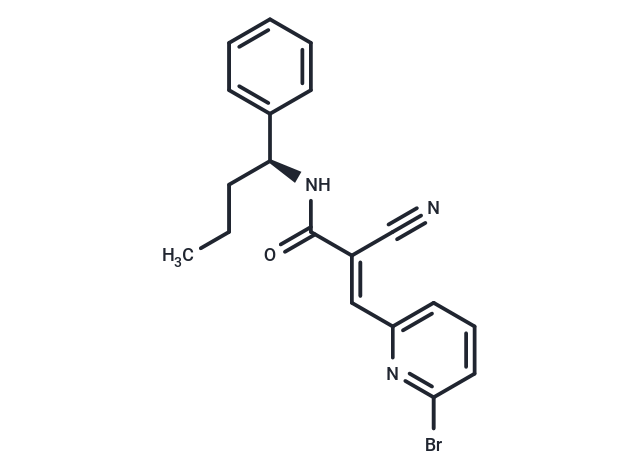Shopping Cart
Remove All Your shopping cart is currently empty
Your shopping cart is currently empty
Degrasyn (WP1130) (WP1130), a specific deubiquitinase (DUB: USP5, UCH-L1, USP9x, USP14, and UCH37) inhibitor, also inhibits Bcr/Abl, which is a JAK2 transducer (without affecting 20S proteasome) and activator of transcription (STAT).

| Pack Size | Price | USA Warehouse | Global Warehouse | Quantity |
|---|---|---|---|---|
| 2 mg | $35 | In Stock | In Stock | |
| 5 mg | $55 | In Stock | In Stock | |
| 10 mg | $93 | In Stock | In Stock | |
| 25 mg | $198 | In Stock | In Stock | |
| 50 mg | $340 | In Stock | In Stock | |
| 100 mg | $531 | - | In Stock | |
| 200 mg | $747 | - | In Stock | |
| 1 mL x 10 mM (in DMSO) | $60 | In Stock | In Stock |
| Description | Degrasyn (WP1130) (WP1130), a specific deubiquitinase (DUB: USP5, UCH-L1, USP9x, USP14, and UCH37) inhibitor, also inhibits Bcr/Abl, which is a JAK2 transducer (without affecting 20S proteasome) and activator of transcription (STAT). |
| Targets&IC50 | BCR-ABL:1.8 μM |
| In vitro | In addition to inducing rapid down-regulation of Bcr/Abl without affecting Bcr or c-Abl, WP1130 also regulates the stability of Jak2 and c-Myc without affecting other kinases (HER1, HER2, c-Kit, FAK, ERK1, ERK2, Akt, Btk, Src and Src-related kinases) or transcription factors (wild-type p53, STAT1, STAT3, STAT5, c-Jun, NF-κB, and Max). Unlike adaphostin and Trisenox, WP1130 induces down-regulation of Bcr/Abl within 60 minutes. WP1130 is more effective in inducing apoptosis of myeloid and lymphoid tumor cells with IC50 of ~0.5-2.5 μM compared with normal CD34+ hematopoietic precursors, dermal fibroblasts, or endothelial cells with IC50 of ~5-10 μM. WP1130 (5 μM) specifically and rapidly down-regulates both wild-type and T315I mutant Bcr/Abl protein without affecting bcr/abl gene expression or engaging the proteasomal degradation pathway in chronic myelogenous leukemia (CML) cells, accompanied by induction of apoptosis. WP1130 is more effective in reducing leukemic cell colony formation compared with normal progenitor cells, and effective against primary leukemic cells harboring the T315I mutation. [1] WP1130 induces rapid proteasomal-dependent degradation of c-Myc protein in MM-1 multiple myeloma and other tumor cell lines, correlated with tumor growth inhibition. [2] Unlike AG490, WP1130 acts as a partly selective deubiquitinase (DUB) inhibitor to induce a rapid and marked accumulation of polyubiquitinated (K48/K63-linked) proteins into juxtanuclear aggresomes without affecting proteasome activity. WP1130 (5 μM) directly inhibits DUB activity of USP9x, USP5, USP14, UCH-L1, and UCH37, but not UCH-L3, resulting in downregulation of antiapoptotic and upregulation of proapoptotic proteins, such as MCL-1 and p53. [3] |
| In vivo | Administration of WP1130 inhibits the growth of K562 tumors as well as both wildtype Bcr/Abl and T315I mutant Bcr/Abl-expressing BaF/3 cells transplanted into nude mice. [1] Consistent with the down-regulation of c-Myc, WP1130 displays potent inhibitory activity against A375 melanoma tumors established in nude mice. [2] |
| Kinase Assay | To determine binding kinetic constants, liver or kidney plasma membranes are incubated with increasing concentrations of [3H]-AVP with or without excess (1 μM) unlabelled AVP to obtain a saturation curve. To investigate whether mozavaptan interacts competitively or noncompetitively, the saturation binding of [3H]-AVP is examined in the absence and presence of mozavaptan at concentrations of 0.3 μM and 1 μM in liver membranes and 3 nM, and 10 nM in kidney membranes. Data on the saturation curve are plotted according to the method of Scatchard and fitted by a regression analysis[1]. |
| Cell Research | Cells are treated with increasing concentrations of WP1130 (0.08-10 μM) in 96-well plates. Plates are incubated at 37 °C for 72 hours, after which 20 μL of MTT reagent is added, and the plates are incubated at 37 °C for another 2 hours. Cells are lysed with 100 μL lysis buffer (20% sodium dodecyl sulfate [SDS] in 50% N, N-dimethylformamide adjusted to pH 4.7 with 80% acetic acid and 1 M hydrochloric acid; final concentration of acetic acid is 2.5% and hydrochloric acid is 2.5%) and incubated for 6 hours. The optical density of each sample at 570 nm is determined with a SPECTRA MAX M2 plate reader.(Only for Reference) |
| Synonyms | WP1130 |
| Molecular Weight | 384.27 |
| Formula | C19H18BrN3O |
| Cas No. | 856243-80-6 |
| Smiles | CCC[C@H](NC(=O)C(=C\c1cccc(Br)n1)\C#N)c1ccccc1 |
| Relative Density. | 1.358 g/cm3 |
| Storage | store at low temperature | Powder: -20°C for 3 years | In solvent: -80°C for 1 year | Shipping with blue ice/Shipping at ambient temperature. | ||||||||||||||||||||||||||||||||||||||||
| Solubility Information | Ethanol: 15 mg/mL (39.04 mM), Sonication is recommended. H2O: < 1 mg/mL (insoluble or slightly soluble) DMSO: 250 mg/mL (650.58 mM), Sonication is recommended. | ||||||||||||||||||||||||||||||||||||||||
| In Vivo Formulation | 10% DMSO+40% PEG300+5% Tween 80+45% Saline: 5 mg/mL (13.01 mM), Sonication is recommended. Please add the solvents sequentially, clarifying the solution as much as possible before adding the next one. Dissolve by heating and/or sonication if necessary. Working solution is recommended to be prepared and used immediately. The formulation provided above is for reference purposes only. In vivo formulations may vary and should be modified based on specific experimental conditions. | ||||||||||||||||||||||||||||||||||||||||
Solution Preparation Table | |||||||||||||||||||||||||||||||||||||||||
Ethanol/DMSO
DMSO
| |||||||||||||||||||||||||||||||||||||||||
| Size | Quantity | Unit Price | Amount | Operation |
|---|

Copyright © 2015-2025 TargetMol Chemicals Inc. All Rights Reserved.